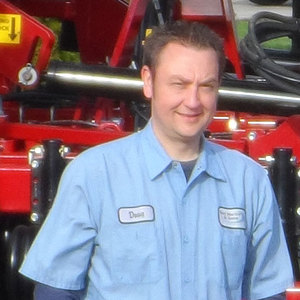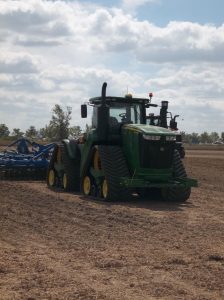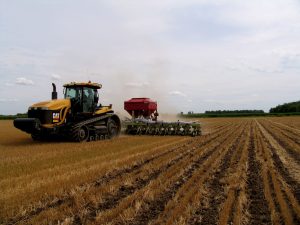Agronomy, Conservation, Homepage Slider
Why do we still see so much tillage across Ohio?
By Dusty Sonnenberg, CCA, Ohio Field Leader
Pick-up any farm publication and chances are you will find an article about the use of cover crops or no-till farming. Drive across any rural county in Ohio and chances are you will find a field that has recently been tilled. With all the current research evaluating best management practices utilizing no-till and cover crops, why do we still see so much tillage across the state?
Just ask a group of farmers gathered at the local elevator or coffee shop what their top reasons for tillage are, and more than likely there will be a rather consistent list. Those reasons often cited include: breaking-up soil compaction, managing crop residue, controlling weeds and diseases, and improving yields. Most will admit that they have tried and like the concept of no-till farming, especially from the standpoint of making fewer trips across the field. In the same conversation however, they will often talk about the challenges they face on heavier soils with compaction issues and managing crop residue.
Doug Martin, General Manager of Paul Martin & Sons has seen an evolution of tillage since his father began their business operations in 1988. When Paul Martin turned his small northwest Ohio used equipment sales and rental operation into a full-time dealership selling new seeding and tillage equipment from the Tye Company, no-till was really growing in popularity.
“The Tye-Drill was the main product we sold as many farmers in the area converted to no-till in the late 80s and early 90s,” Martin said. “In a few years, challenges posed by the heavy northwest Ohio clay soils and heavy residue from corn caused many to look for other alternatives. Many had to gravitate back to use some tillage to manage the residue. Full no-till farming takes a lot of management to make it work correctly, and in some situations, it is just not the right fit. Tillage can make farming a little easier.”
Martin believes that tillage tools in the future will need to be multi-purpose.
“These machines are expensive, and they require a good deal of horsepower to pull. That is one reason our rental business has been strong, because a lot of farmers cannot justify owning a tractor that large and a single purpose tillage tool. Vertical tillage takes less horsepower relative to the requirements for performing deep tillage,” Martin said. “As the tillage tools have changed and gotten wider, the horsepower requirements have increased. A 200 to 250 horsepower tractor is about the minimum to pull most of the newer technology that will move the soil. A ge neral rule of thumb is 12 to 15 horsepower per foot of machine.”
neral rule of thumb is 12 to 15 horsepower per foot of machine.”
Much of the newest technology will allow for the machine to be changed based on either the changing conditions, or desired practice and results in a given year. Some of the new machines can adjust the angle of the disk/coulter gangs from 0 to 13 degrees depending on the amount of soil desired to be moved.
Tillage can also help produce better yields in some situations.
“For corn following corn, fall tillage can noticeably increase yields in fields with medium- or fine-textured soil,” said Tony Vyn, the Henry A. Wallace Chair in Crop Sciences and professor of agronomy at Purdue University. “It doesn’t need to be very intensive tillage or tillage that goes down to depths of 12 or 13 inches. It can be as simple as a single pass of strip tillage, where it reaches a depth of 8 or 9 inches and forms berms between corn rows from this year so that it enables a stale seedbed planting system next spring.”
Potential crop yield gains should at a minimum offset the cost of any tillage. According to the 2018 Ohio Farm Custom Rates, compiled by The Ohio State University Extension, running a disk chisel averages $18 per acre, and a soil finishing pass is $15.50 per acre. That totals $33.50 per acre that must be offset by an increase in yield. At $3.65 corn and $8.85 soybeans, that would take an increase of 4.25 bushels per acre of corn or 1.75 bushels per acre of soybeans.
There are a many variations when farmers discuss tillage, from full tillage with 100% soil disruption and burying residue to vertical tillage with almost no soil being displaced.
“A farmer cannot be so in love with just one tillage practice that they only do that. They need to be flexible and implement different practices in different years. Farmers are very experimental, and are willing to try different things to solve a problem, however their tolerance for risk and loss of profit only goes so far,” Martin said. “Breaking up compaction on the end rows and high traffic areas will require a different action than that of sizing residue and pinning it to the soil so it does not move off the field during the winter and spring.”
Every farm has its own unique challenges and different sets of circumstances.
“In some cases, fields are still rough from the ruts created during the wet harvest conditions. In those field and field-area specific situations, fall tillage operations may have additional justification. But recognize that tillage is always only a partial solution on compaction-damaged soils,” Vyn said. “Farmers are encouraged to think carefully through their reasons for doing a particular tillage operation on each field, and recognize that other management factors like crop rotation, hybrid selection and nutrient management will likely have much more impact on the final corn yield than the tillage system itself. As always, concern for soil conservation should be paramount. Soil that is less subject to wind and water erosion events during that long exposure period will be more likely to be kept in place for near-term and long-term yield benefits.”